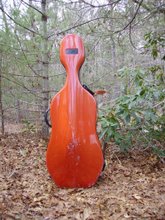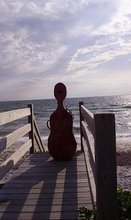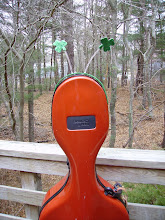I was delighted to receive the very generous gift of an iPad from my daughter this Christmas. I wanted one primarily to store sheet music. One of the women in the women's fiddle group I play with already had one. She plays the tin whistle, so it is a little easier for her to position the iPad close enough for her to see it when she plays, but it is, I have found, quite possible to use a iPad for cello music too.
So, I walked into the women's fiddle group this past Saturday, with my new iPad (still very few songs in my sheet musica library, and not yet ready to play from it,) I was amazed to see three other women with iPads--and actually using them!
I haven't seen anyone locally using the iPad for classical music, but the fiddleers have really embraced it. In part, this is because, I think, that fiddle tunes are short and more easily viewed on an iPad than more complex classsical musc, and because there is an abundance of online fiddle music libraries already formatted for iPad. Fewer for cello--I have to transpose a lot of the fiddle music for cello or otherwise convert the music to PDF.
The Borromeo String Quartet uses laptop computers to store and play from their sheet music, but such use of digital devices is still apparently rare in the classical world.
I am currently using a program called Scorecerer to store PDF files. It also allows you to ddfingerings, bowings, and other markings, just as you might with a pencil, except you mark with your finger. There are some other programs I might also try, but for now, I think I need to focus on getting my music into PDF files so I can actually use this wonderful little device in sessions.
Monday, January 9, 2012
Friday, January 6, 2012
Orchestra Music
It was nice to get back to orchestra this week, though the music is challenging. We (the cello section) received an e-mail the day before the rehearsal with fingerings for Samuel Barber's "Adagio for Strings." It is in five flats, with bass, tenor, and treble clef--goes up to a high G flat, but only briefly. The rest remains more playable, no higher than a high D, thumb-positiony.
After going over it a bit, myself, in orchestra, and with my teacher today, I think that it is going to be as horrendous as I though it would be.
It is, at least, adagio. The hard part might be remember which clef I am in.
Here is a fine version of the piece, conducted by Mstislav Rostropovich:
There are eight other pieces, all with their own challenges.
I am very happy to be playing Bach's Fugue in G Minor (the Lesser), which I used to play with my flute quartet. Playing it fast enough will be the issue.
We are also playing "The Stars and Stripes Forever," which I know well from playing it on flute every week in the summer during our Town Band concerts. It is fun taking the lower part for a change.
Our pops tune is Andrew Lloyd Webber's "Symphonic Reflections," a medley of Jesus Christ Superstar, Don't Cry for Me Argentina, King Herod's Song, and Memory. That one seems pretty doable.
Unfamiliar to me is "Tatarian Dances" by Elena Roussanova Lucas. We don't have much in the way of melody, but I really like these dances.
"Band of Brothers" by Michael Kamen has an unrelenting section of triplets that will require some focused playing, and counting.
We are also playing "Variations on a Theme by Handel," by Maurice Whitney, "Legend" by Merle Isaac, "Poem Symphonique 'Les Preludes,'" by Franz Liszt.
It will keep us busy for a while.
After going over it a bit, myself, in orchestra, and with my teacher today, I think that it is going to be as horrendous as I though it would be.
It is, at least, adagio. The hard part might be remember which clef I am in.
Here is a fine version of the piece, conducted by Mstislav Rostropovich:
There are eight other pieces, all with their own challenges.
I am very happy to be playing Bach's Fugue in G Minor (the Lesser), which I used to play with my flute quartet. Playing it fast enough will be the issue.
We are also playing "The Stars and Stripes Forever," which I know well from playing it on flute every week in the summer during our Town Band concerts. It is fun taking the lower part for a change.
Our pops tune is Andrew Lloyd Webber's "Symphonic Reflections," a medley of Jesus Christ Superstar, Don't Cry for Me Argentina, King Herod's Song, and Memory. That one seems pretty doable.
Unfamiliar to me is "Tatarian Dances" by Elena Roussanova Lucas. We don't have much in the way of melody, but I really like these dances.
"Band of Brothers" by Michael Kamen has an unrelenting section of triplets that will require some focused playing, and counting.
We are also playing "Variations on a Theme by Handel," by Maurice Whitney, "Legend" by Merle Isaac, "Poem Symphonique 'Les Preludes,'" by Franz Liszt.
It will keep us busy for a while.
Sunday, January 1, 2012
Cello Resolution!
I am in my 12th year as an adult beginner. Sometime I think I am making excellent progress and am clearly an adult intermediate! Other times, such as when I record myself, I am distressed at the sound I make, Not music at all. Funny how the ear seems to correct pitches and rhythms and emotive content when one is listening to oneself play; yet the ear is not tricked by a recording. Yikes. Suddenly one can really hear how one sounds.
At least this is the case for me. But, something about the cello pulls me onward. A good practice session makes me think, yes, I can do this. The trouble is that the good practice sessions are not so frequent as they ought to be.
So, here is my simple resolution for the new year, bright, hopeful 2012: to practice every day, even those jam-packed days when work consumes my every waking minute.
I want to improve pitch, vibrato, dynamics, and musicality.
Orchestra starts this week, and I want to, for once, feel really confident of my playing. This means more time spent on practicing the pieces than I have in the past.
Fiddle music is ongoing, and I want to improve my ability to play by ear, to increase my repertoire of fiddle tunes (by memory/ear) by one a month. My favorite fiddle tunes for cello are still those by Abby Newton.
I hope to play cello duets or trios with others this year, depending on everyone's busy schedules.
Finally, I need to spend more time on scales and etudes. I know they are important, but I tend to skip over them to quickly.
I started on the resolution early, since I had the time off around the holidays. I have now practiced 2 hours a day for four days in a row. I don't expect to be able to continue that, but, as they say, even 10 minutes on those busy days is better than skipping a day.
Happy New Year to all!
At least this is the case for me. But, something about the cello pulls me onward. A good practice session makes me think, yes, I can do this. The trouble is that the good practice sessions are not so frequent as they ought to be.
So, here is my simple resolution for the new year, bright, hopeful 2012: to practice every day, even those jam-packed days when work consumes my every waking minute.
I want to improve pitch, vibrato, dynamics, and musicality.
Orchestra starts this week, and I want to, for once, feel really confident of my playing. This means more time spent on practicing the pieces than I have in the past.
Fiddle music is ongoing, and I want to improve my ability to play by ear, to increase my repertoire of fiddle tunes (by memory/ear) by one a month. My favorite fiddle tunes for cello are still those by Abby Newton.
I hope to play cello duets or trios with others this year, depending on everyone's busy schedules.
Finally, I need to spend more time on scales and etudes. I know they are important, but I tend to skip over them to quickly.
I started on the resolution early, since I had the time off around the holidays. I have now practiced 2 hours a day for four days in a row. I don't expect to be able to continue that, but, as they say, even 10 minutes on those busy days is better than skipping a day.
Happy New Year to all!
Subscribe to:
Posts (Atom)











